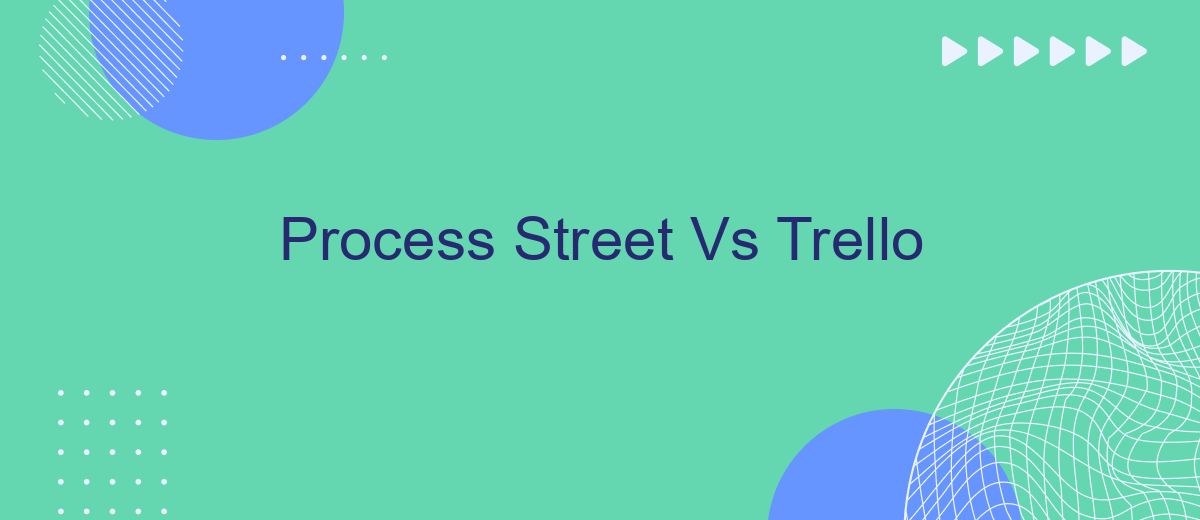Choosing the right project management tool can significantly impact your team's productivity and workflow. In this article, we compare Process Street and Trello, two popular platforms designed to streamline tasks and improve efficiency. We'll explore their features, strengths, and weaknesses to help you decide which tool best suits your needs. Read on to find out which platform comes out on top.
Introduction
In today's fast-paced business environment, efficient task management is crucial. Two popular tools that help teams stay organized and productive are Process Street and Trello. Both platforms offer unique features tailored to different types of workflows, making it essential to understand their strengths and weaknesses before choosing the right one for your team.
- Process Street: Ideal for creating and managing recurring checklists and standard operating procedures (SOPs).
- Trello: Known for its visual Kanban boards, making it easy to track tasks and projects at a glance.
- Integration Capabilities: Both tools offer integrations with various third-party services to streamline workflows.
Choosing between Process Street and Trello depends on your specific needs and the nature of your projects. For those looking to automate integrations, services like SaveMyLeads can further enhance the functionality of both platforms by connecting them with other essential tools. Understanding these nuances will help you make an informed decision and optimize your team's productivity.
Features Comparison

When comparing Process Street and Trello, it's important to note that both platforms offer robust features tailored to different project management needs. Process Street excels in providing detailed process templates and checklists, making it ideal for teams that need to follow strict workflows. It also offers advanced automation options, which can save time and reduce human error. On the other hand, Trello is known for its user-friendly interface and customizable boards, lists, and cards. This makes it a versatile tool for a wide range of projects, from simple to complex, and it’s particularly popular for agile project management.
Both Process Street and Trello offer integration capabilities with various third-party apps to enhance their functionality. For instance, SaveMyLeads can be used to automate the integration of leads from different sources directly into these platforms, streamlining the workflow and ensuring no lead is missed. While Process Street focuses more on workflow automation and detailed task management, Trello offers flexibility with its power-ups and easy-to-use drag-and-drop interface. Ultimately, the choice between the two depends on the specific needs and preferences of your team.
Pricing and Plans

When comparing Process Street and Trello, one crucial aspect to consider is their pricing and plans. Both platforms offer a range of options to cater to different needs and budgets.
- Process Street: Process Street offers a free plan with limited features, ideal for small teams or personal use. Their paid plans start at .50 per user per month, providing advanced features such as conditional logic, task permissions, and integrations with other tools through services like SaveMyLeads.
- Trello: Trello also provides a free plan with basic functionalities suitable for individuals or small projects. Their Business Class plan is priced at .50 per user per month, which includes additional features like unlimited boards, advanced checklists, and priority support. For larger organizations, Trello offers an Enterprise plan with custom pricing based on specific needs.
Overall, both Process Street and Trello offer flexible pricing plans to accommodate various user requirements. While Process Street may appeal to those needing advanced workflow automation and integrations, Trello is a strong contender for its user-friendly interface and extensive customization options. Depending on your specific needs, either platform can provide excellent value for your investment.
Pros and Cons

When comparing Process Street and Trello, it's essential to consider the strengths and weaknesses of each platform. Both tools are designed to improve workflow management, but they cater to different needs and preferences.
Process Street excels in structured process management, making it ideal for businesses that require detailed documentation and repetitive task automation. On the other hand, Trello's flexible board and card system is perfect for visual project management and team collaboration.
- Process Street Pros: Advanced process automation, detailed documentation, powerful integrations.
- Process Street Cons: Steeper learning curve, less visual appeal.
- Trello Pros: User-friendly interface, highly visual, versatile for various projects.
- Trello Cons: Limited process automation, less suitable for complex workflows.
For those looking to integrate multiple tools seamlessly, services like SaveMyLeads can be a valuable addition. SaveMyLeads allows users to automate lead management and integrate various platforms without coding, enhancing the capabilities of both Process Street and Trello.
Conclusion
In conclusion, both Process Street and Trello offer unique features that cater to different workflow needs. Process Street excels in structured processes and detailed documentation, making it ideal for teams that require step-by-step task management. On the other hand, Trello's visual board system provides flexibility and simplicity, which is perfect for creative projects and agile teams. Choosing the right tool depends largely on your specific requirements and how you prefer to visualize and manage tasks.
Moreover, integrating these tools with other services can significantly enhance their functionality. For instance, using a service like SaveMyLeads can automate the process of capturing and organizing leads, seamlessly integrating with both Process Street and Trello. This can save time and reduce manual data entry, allowing teams to focus more on their core activities. Ultimately, the best choice will depend on your team's workflow, the complexity of your projects, and the specific integrations you need.


FAQ
What are the main differences between Process Street and Trello?
Can I automate tasks in Process Street and Trello?
Which tool is better for team collaboration?
Can I integrate these tools with other applications?
Which tool is easier to use for beginners?
Would you like your employees to receive real-time data on new Facebook leads, and automatically send a welcome email or SMS to users who have responded to your social media ad? All this and more can be implemented using the SaveMyLeads system. Connect the necessary services to your Facebook advertising account and automate data transfer and routine work. Let your employees focus on what really matters, rather than wasting time manually transferring data or sending out template emails.
